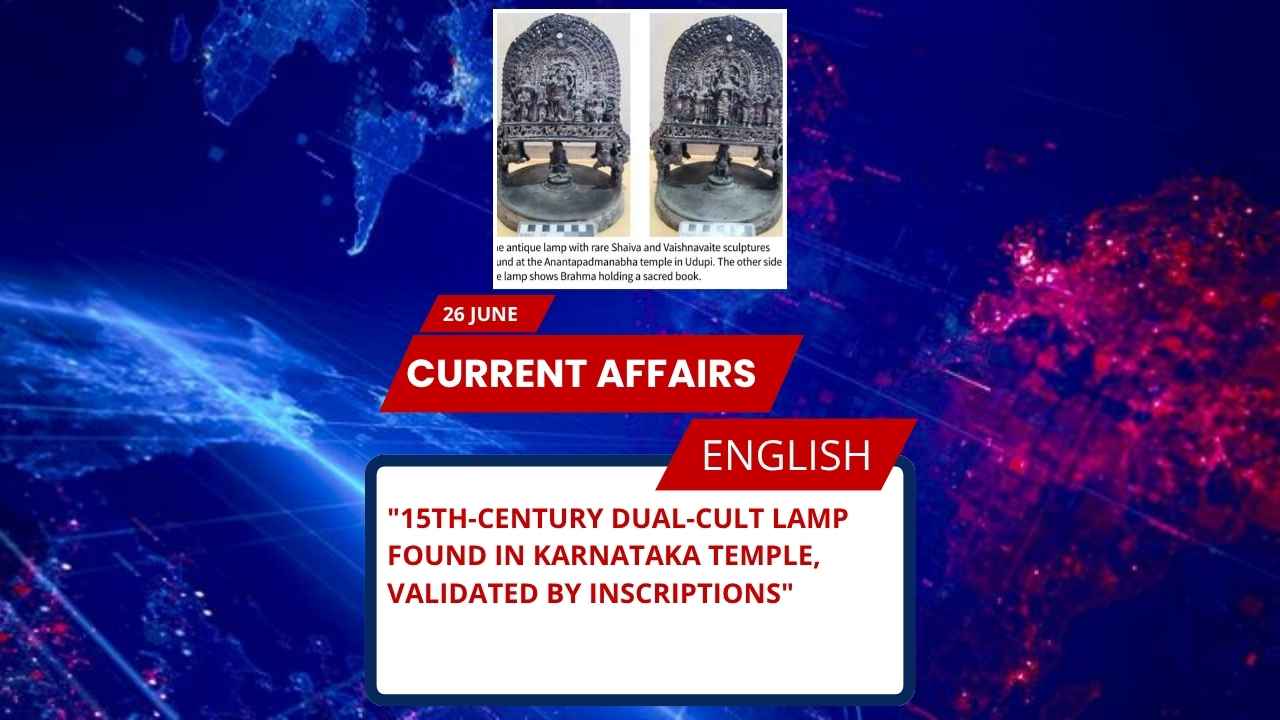
Key Points for SSC/UPSC and Other Government Exams
- Discovery Location: Anantapadmanabha Temple, Perdoor, Udupi district, Karnataka
- Period: 15th Century (Year 1456 CE confirmed via inscription)
- Artifact Type: Antique lamp with both Shaiva and Vaishnava sculptures
- Donor: Basavannaras Banga (as per stone inscription)
- Expert Authentication: Confirmed by archaeologist T. Murugeshi
- Iconography: Nataraja (Shiva), Anantapadmanabha (Vishnu), divine characters from Puranic narratives
- Religious Harmony: Symbolizes syncretism of Shaiva and Vaishnava traditions
- Cultural Significance: Important for temple art, Indian iconography, and Bhakti tradition research
Full Report: 15th-Century Dual-Cult Lamp Discovery in Karnataka
Why This Discovery Matters
A rare antique lamp, believed to be from the 15th century, has been unearthed from the Anantapadmanabha Temple in Perdoor, located in the Udupi district of Karnataka. What makes this lamp historically significant is its unique sculptural integration of both Shaiva and Vaishnava deities, presenting a rare visual narration of India’s pluralistic spiritual traditions.
Epigraphical Evidence
A stone inscription dated 1456 CE clearly attributes the donation of this lamp to Basavannaras Banga, establishing its provenance and authenticity. The inscription adds archaeological value and confirms its place in India’s medieval religious history.
Expert Validation
T. Murugeshi, a reputed historian and archaeologist, examined the artifact and confirmed that it represents a dual-cultic symbolism—rare in Indian temple art. He emphasized its narrative depth and sculptural integrity, highlighting its importance for religious harmony and ritual traditions.
Sculptural Highlights of the Lamp
Shaiva Side
- Central Deity: Shiva as Nataraja performing Pralaya Tandava (destructive cosmic dance)
- Accompanying Figures: Parvati, Ganesha, Kartikeya (Kumara), Bringi
- Supporting Characters: Khadga Ravana and Goddess Mari
- Iconography: Symbolizes cosmic destruction and rebirth
Vaishnava Side
- Main Deity: Lord Anantapadmanabha (a reclining form of Vishnu)
- Other Figures: Brahma, Indra, Agni, and Varuna
- Theme: Depicts gods appealing to Anantapadmanabha to pacify Shiva’s fury
Symbolism
At the base of the lamp, a central Garuda (vahana of Vishnu) is depicted in a devotional posture, while Lord Shiva appears behind him, calmed and folded in Anjali mudra. This visual representation symbolizes divine mediation and cosmic balance.
Importance in Indian Temple Art and Iconography
Definition:
Indian temple iconography refers to the symbolic representation of deities, mythological stories, and philosophical ideas through sculpture and architecture.
Key Elements:
- Mudras: Symbolic hand gestures
- Vahanas: Mounts of gods (e.g., Garuda, Nandi)
- Narratives: Derived from Puranas and epics
- Purpose: Ritual, educational, and aesthetic
- Styles: Dravidian (South), Nagara (North), Vesara (Deccan)
Cultural Relevance:
This lamp demonstrates religious syncretism, iconographic continuity, and regional artistic expression, enriching the study of Indian temple heritage.
State Profile: Karnataka (Relevant for Exams)
- Capital: Bengaluru
- Chief Minister (as of 2025): Siddaramaiah
- Governor: Thaawarchand Gehlot
- Major Rivers: Krishna, Kaveri, Tungabhadra
- Important National Parks:
- Bandipur National Park
- Nagarhole National Park
- Bannerghatta National Park
- Famous Temples:
- Udupi Sri Krishna Matha
- Hoysaleswara Temple, Halebidu
- Chennakesava Temple, Belur
- UNESCO Sites: Hampi, Pattadakal
Expected Exam Questions (MCQs)
1. In which Indian state was the 15th-century dual-cult lamp discovered recently?
A. Tamil Nadu
B. Karnataka
C. Andhra Pradesh
D. Kerala
Correct Answer: B. Karnataka
2. What is the significance of the antique lamp found in Perdoor, Udupi?
A. It depicts Buddhist and Jain deities
B. It was made of gold
C. It represents both Shaiva and Vaishnava traditions
D. It was donated by Tipu Sultan
Correct Answer: C. It represents both Shaiva and Vaishnava traditions
3. Who donated the antique lamp to Anantapadmanabha Temple as per inscription?
A. T. Murugeshi
B. Basavannaras Banga
C. Harihara II
D. Raja Krishnadevaraya
Correct Answer: B. Basavannaras Banga
4. What dance of Shiva is depicted on the lamp?
A. Tandava of Creation
B. Ananda Tandava
C. Pralaya Tandava
D. Shiva-Parvati Tandava
Correct Answer: C. Pralaya Tandava
5. Who is shown mediating between angry Shiva and other gods in the lamp’s narrative?
A. Indra
B. Garuda
C. Vishwakarma
D. Ganesha
Correct Answer: B. Garuda
UPSC-Type FAQs with Model Answers
Q1: Discuss the significance of the dual-religious iconography found in the 15th-century lamp discovered in Karnataka.
Answer:
The recently discovered 15th-century lamp from the Anantapadmanabha Temple in Karnataka reflects India’s deep-rooted cultural and religious syncretism. By depicting both Shaiva (Nataraja, Parvati, Ganapati) and Vaishnava (Anantapadmanabha, Brahma, Indra) elements, it showcases the coexistence and philosophical integration of major Hindu sects. The visual narrative not only has spiritual depth but also demonstrates the temple’s role in preserving complex theological ideas through art. This kind of integration is crucial for understanding medieval religious practices, sectarian harmony, and the use of iconography as a means of communication in pre-modern India.
Q2: How do epigraphical sources aid in validating archaeological finds like the Perdoor lamp?
Answer:
Epigraphical records such as inscriptions serve as primary historical evidence to validate the chronology and patronage of archaeological artifacts. In the case of the Perdoor lamp, the 1456 CE inscription mentioning Basavannaras Banga as the donor authenticates the artifact’s antiquity. Such inscriptions provide direct context, link artifacts to historical figures, and offer insights into socio-religious practices of the time. This strengthens the reliability of archaeological interpretations and supports interdisciplinary studies involving history, art, and religion.
Q3: Explain the role of Indian temple iconography in preserving religious and cultural narratives.
Answer:
Indian temple iconography plays a pivotal role in visually preserving religious doctrines, cultural ethos, and mythological narratives. Sculptures, carvings, and symbolic representations in temples act as didactic tools to communicate complex philosophical ideas to the devotees. The use of Puranic stories, divine postures, and ritual elements reinforces the Bhakti movement’s core messages and ensures continuity of tradition across generations. Artifacts like the Perdoor lamp become mobile embodiments of such iconography, especially when they carry multifaceted depictions like those of Shiva and Vishnu in a single artifact, demonstrating the dynamic nature of Indian spiritual heritage.







